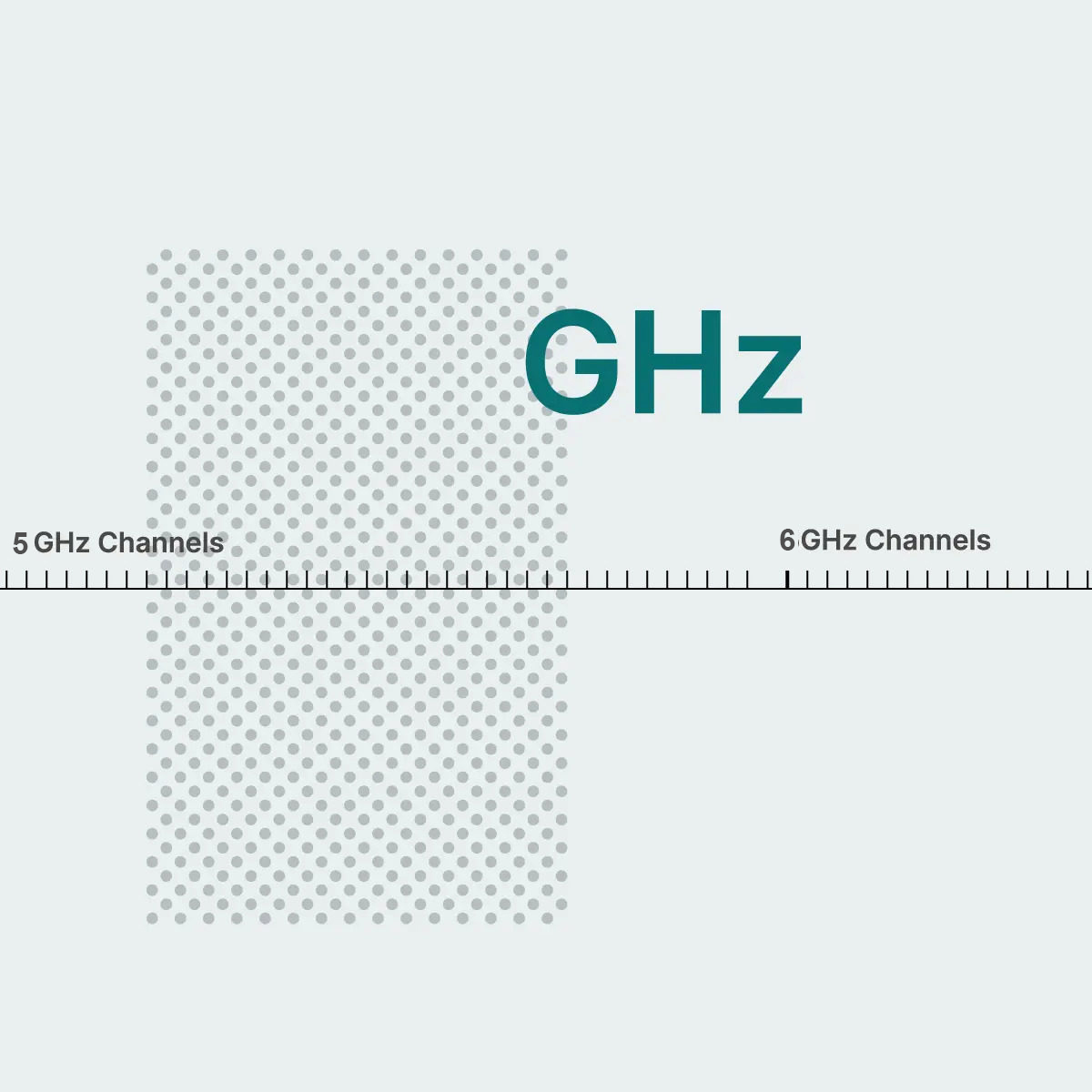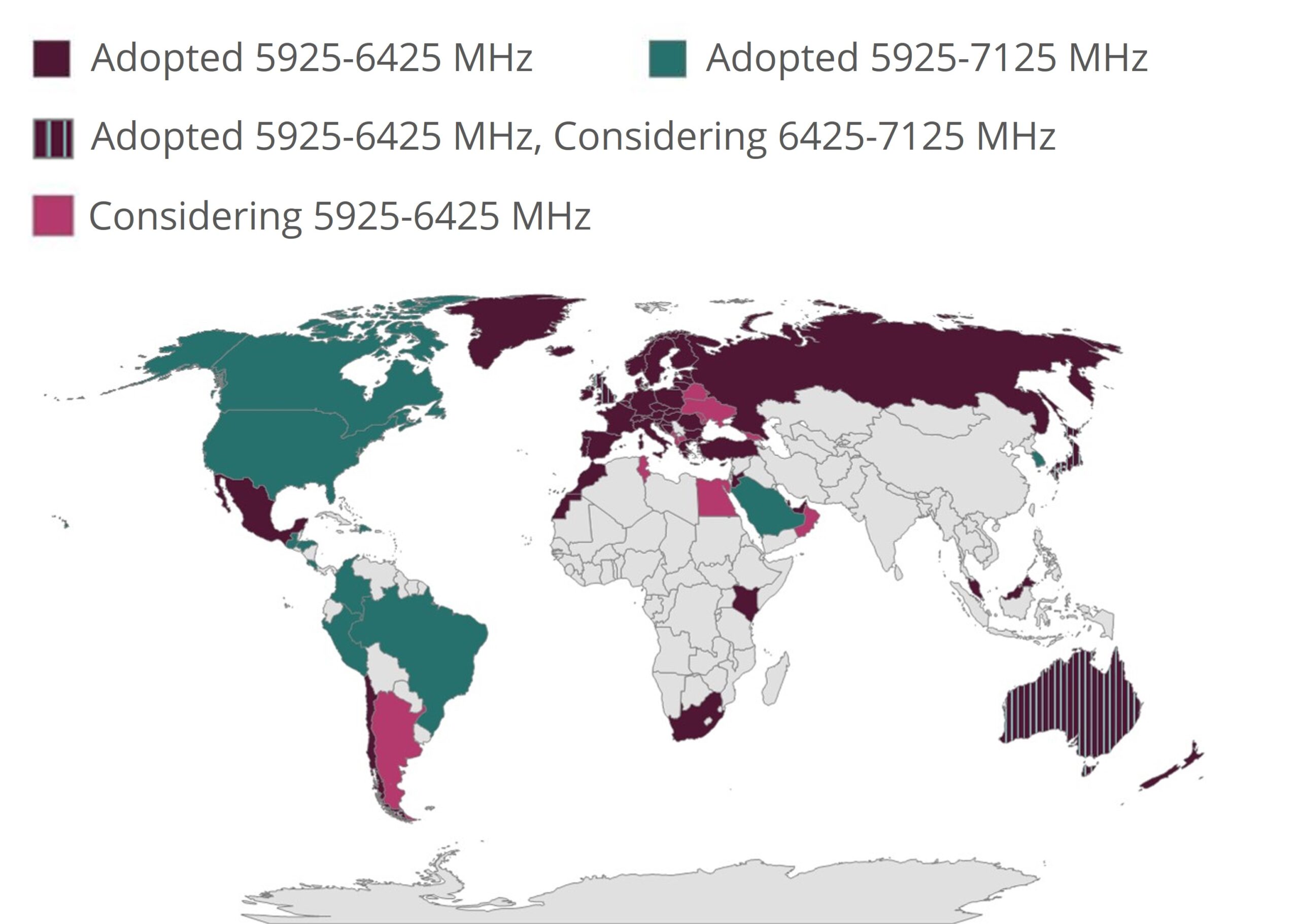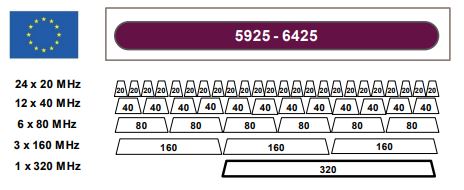
Technical Guide to 6GHz for MSPs, ISPs and SPs
After only two years after the approval by the FCC regulations and Wi-Fi Alliance (and the progressive approval by the national regulatory authorities in Japan, UE, Latin America) to open up the 6GHz band for unlicensed Wi-Fi broadcasting, the main networking OEMs have already launched the first WiFi6E access points.
Wi-Fi 6 APs constituted more than 76% of the shipments in the period according to IDC.
This technical guide is quite long, but its length is fundamental to explain all the facets of the revolutionary 6Ghz.
Readers can click on the following links to jump to the interested section.
– The 6GHz band frequency
– What are the benefits of the 6GHz band?
– Features introduced by the 6GHz band
– Airtime efficiency
– Faster passive/active AP discovery
– What is the difference between 2.4 GHz, 5 GHz, and 6 GHz?
– List of Tanaza Powered Devices and Tanaza Compatible Devices that supports 6GHz
The 6GHz band frequency
While the 6 GHz band is continuous and channelized across the entire 1200 MHz, network users are active in all sub-bands. The 6 GHz band frequency uses 59 channels of 20 MHz bandwidth. The channel numbers overlap with the current 2.4 GHz and 5 GHz band.
Following the same distribution model of the other bands, each country has enabled the spectrum in different sub-bands.
The FCC has designated four sub-bands for the US territory: U-NII-5, 6, 7, and 8.
The EU Commission, instead, allows network operators to exploit the “U-NII-5 equivalent” part of the band, the lower one: 480 MHz after the 20 MHz guard band.

| Countries | Status | Spectrum |
|---|---|---|
| Argentina | Considering | 5925-6425 MHz |
| Australia | Adopted - Considering | 5925-6425 MHz - 6425-7125 MHz |
| Bahrain | Adopted | 5925-6425 MHz |
| Brazil | Adopted | 5925-7125 MHz |
| CEPT | Considering | 5925-6425 MHz (*only considering 5945-6425) |
| Canada | Adopted | 5925-7125 MHz |
| Chile | Adopted | 5925-6425 MHz |
| Colombia | Adopted | 5925-7125 MHz |
| Costa Rica | Adopted | 5925-7125 MHz |
| Dominican Republic | Adopted | 5925-7125 MHz |
| Egypt | Considering | 5925-6425 MHz |
| European Union | Adopted | 5925-6425 MHz (*only adopting 5945-6425) |
| Guatemala | Adopted | 5925-7125 MHz |
| Honduras | Adopted | 5925-7125 MHz |
| Hong Kong | Adopted - Considering | 5925-6425 MHz - 5925-7125 MHz |
| Iceland | Adopted | 5925-6425 MHz (*only adopting 5945-6425) |
| Japan | Considering | 5925-6425 MHz - 5925-7125 MHz |
| Jordan | Adopted | 5925-6425 MHz |
| Kenya | Adopted | 5925-6425 MHz |
| Liechtenstein | Adopted | 5925-6425 MHz (*only adopting 5945-6425) |
| Malasya | Adopted | 5925-6425 MHz |
| Mauritius | Adopted | 5925-6425 MHz |
| Mexico | Adopted | 5925-6425 MHz |
| Morocco | Adopted | 5925-6425 MHz |
| New Zeland | Adopted | 5925-6425 MHz |
| Norway | Adopted | 5925-6425 MHz |
| Oman | Considering | 5925-6425 MHz |
| Peru | Adopted | 5925-7125 MHz |
| Qatar | Considering | 5925-6425 MHz - 5925-7125 MHz |
| Saudi Arabia | Adopted | 5925-7125 MHz |
| Russian Federation | Adopted | 5925-6425 MHz |
| South Africa | Adopted | 5925-6425 MHz |
| South Korea | Adopted | 5925-7125 MHz |
| Switzerland | Adopted | 5925-6425 MHz |
| Tunisia | Considering | 5925-6425 MHz |
| Turkey | Adopted | 5925-6425 MHz |
| United Arab Emirates | Adopted | 5925-6425 MHz |
| United Kingdom | Considering | 5925-6425 MHz - 6425-7125 MHz |
| United States | Adopted | 6425-7125 MHz |
These data are updated at 04/19/2023
This band frequency includes the orthogonal frequency-division multiple access (OFDMA) feature from cellular technologies, which takes advantage of servicing multiple users on sub-channels transmitted simultaneously. 6GHz supports the native orthogonal frequency division.
OFDMA allows the transmission of significant quantities of data over a single noisy channel. This technique works by splitting a single signal into multiple smaller transmitted signals. OFDMA is perfect for medium-far transmissions, while MU MIMO is more indicated for short-range.
6 GHz spectrum access approaches
Dynamic random spectrum access and contentionbased protocols require access to multiple channels to maintain acceptable performance.

6 GHz spectrum access approaches for Europe

6 GHz spectrum access approaches for worldwide countires (except Europe)
What are the benefits of the 6GHz band?
< Low levels of latency – Fully-Scheduled Traffic
> High Capacity on Cutting edge-devices
> More precise positioning
> More than 700 access points of the market supports 6GHz
Features introduced by the 6GHz band
– airtime efficiency;
– faster passive/active AP discovery.
Airtime efficiency
Beacon Changes
Multi-BSSID Beacon
New Rules for Probing
It allows probes in PSC channels.
Faster passive/active AP discovery
6GHz Passive AP discovery
Fast Initial Link Setup (FILS) AP discovery
Unsolicited probe response frames AP discovery
6GHz Active AP discovery
Preferred Scanning Channels (PSC)
Instead of scanning the entire 6 GHz spectrum for an optimal channel, devices that support 6GHz can scan PSCs for efficient connectivity. Clients can only send probes requests on every fourth 20 MHz channel.
The complete list of all the 6 GHz PSC channels is 5, 21, 37, 53, 69, 85, 101, 117, 133, 149, 165, 181, 197, 213, 229.
What is the difference between 2.4 GHz, 5 GHz, and 6 GHz?
| Band | 20MHz Channels | 40MHz Channels | 80MHz Channels | 160MHz Channels |
|---|---|---|---|---|
| 2.4GHz | 11 | 2 | N/A | N/A |
| 5GHz | 37 | 18 | 9 | 4 |
| 6GHz | 59 | 29 | 14 | 7 |
Theoretical number of available channels on each band
| Channel Width | Valid Channel Numbers | Number of PSC Channels | PSC Channel Numbers |
|---|---|---|---|
| 20 MHz | 1, 5, 9, 12, 17, 21, 25, 29, 33, 37, 41, 45, 49, 53, 57, 61, 65, 69, 73, 77, 81, 85, 89, 93, 97, 101, 105, 109, 113, 117, 121, 125, 129, 133, 137, 141, 145, 149, 153, 157, 161, 165, 169, 173, 177, 181, 185, 189, 193, 197, 201, 205, 209, 213, 217. 221, 225, 229, 233 | 15 | 5, 21, 37, 53, 69, 85, 101, 117, 133, 149, 165, 181, 197, 213, 229 |
| 40MHz | 1-5, 9-13 17-21, 25-29, 33-37, 41-45, 49-53, 57-61, 65-69, 73-77, 81-85, 99-93, 97-101, 105-109, 113-117, 121-125, 129-133, 137-141, 145-149, 153-157, 161-165, 169-173, 177-181, 185-189, 193-197,201 205, 209 213, 217-221, 225-229 | 15 | 5, 21, 37, 53, 69, 85, 101, 117, 133, 145, 165, 181, 197, 213, 229 |
| 80GHz | 1, 13, 17, 29, 33, 45, 49, 61, 65, 77, 81, 93, 97, 109, 113, 125, 129, 141, 145, 157, 161, 173, 177, 189, 193, 205, 209, 221 | 14 | 5, 21, 37, 53, 69, 85, 101, 117, 133, 145, 165, 181, 197, 213 |
| 160GHz | 1-29, 33-61, 65-93, 97-125, 129-157, 161-189, 193-221 | 7 | 5/21, 37/53, 69/85, 101/117, 133/149, 165/181, 197/213 |
Valid channels number and PSC Channels in 6GHz radio
Is it better to connect to 2.4 GHz, 5GHz or 6GHz?
The best frequency among these depends on inherent hardware features and the real-time radio-frequency environment.
Tanaza cloud management dashboard has specific features with which network engineers can easily manage hundreds or thousands of AP frequencies. They can switch from 2.4GHz to 5 GHz (and soon also to 6GHz thanks to the release of new Tanaza Powered Devices and Tanaza Compatible Devices)
For each AP, MSPs, ISPs, and SPs can select the radio mode, the channel and channel width, and the TX power.
To obtain the maximum signal spread and reduce the propagation loss, the technical conformation of each frequency suggests using the 2.4GHz band for 2.4 GHz radio-supported devices and IoT devices. Older 5Ghz may fall into a ‘legacy’ category and be moved to this band to avoid dragging down the performance of preferred clients in the 5 GHz band.
5 GHz becomes the band for mainstream high-performance devices that are not 6 GHz capable, allowing non-preferred devices to be relegated to 2.4 GHz as above.
The 6 GHz band can be used for the latest, highest-performance devices, almost by definition in the first few years of rollout. It benefits not only from the highest rates available but also from the lack of legacy equipment and lower noise levels in the band.
Read more tips to execute an accurate WiFi channel selection
Try Tanaza
Experience the power of managing WiFi access points from the cloud with Tanaza. Soon also in 6GHz radio frequency.
✔︎ No credit card required ✔︎ Free up to 3 APs



